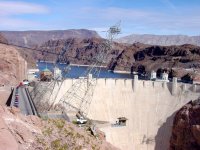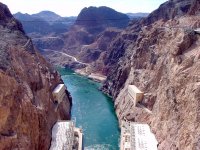The temple of Artemis at Ephesus
The Mausoleum at Halicarnassus
The Hanging Gardens of Babylon

Location: Arizona and Nevada, USA
Completion Date: 1936
Cost: $165 million
Reservoir Capacity: 1.24 trillion cubic feet
Type: Gravity
Purpose: Hydroelectric power
Reservoir: Lake Mead
Materials: Concrete
Engineer(s): Bureau of Reclamation
In 1931, during the height of the Depression, thousands of American workers came to the Black Canyon on the Arizona-Nevada border to tame the Colorado River. They began construction on what would be the largest dam of its time -- the Hoover Dam. But before the dam could be built, workers had to divert the wild Colorado River away from the construction site. How did they do this? They blasted tunnels -- as big as four-lane highways -- right through the canyon walls. For the next five years, the Colorado River gushed through these diversion tunnels while 8,000 workers toiled in the harsh, dry canyon bottom. Amazingly, they completed the dam in less than five years -- ahead of schedule and under budget.
The Hoover Dam is a curved gravity dam. Lake Mead pushes against the dam, creating compressive forces that travel along the great curved wall. The canyon walls push back, counteracting these forces. This action squeezes the concrete in the arch together, making the dam very rigid. This way, Lake Mead can't push it over.
Today, the Hoover Dam is the second highest dam in the country and the 18th highest in the world. It generates more than four billion kilowatt-hours a year -- that's enough to serve 1.3 million people.

